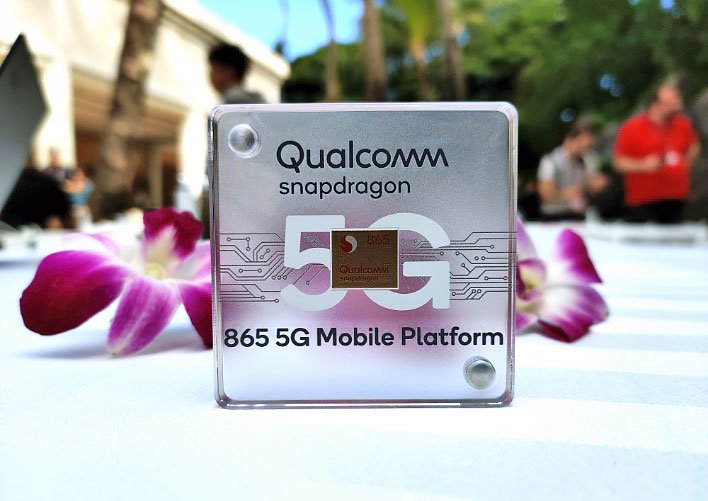Here's Why Snapdragon 765 Could Be The True 5G Volume Power Play From Qualcomm
The vast majority of Android smartphones are powered by Qualcomm Snapdragon processors, and the company this week announced two new SoCs that are 5G-enabled: the Snapdragon 865 Mobile Platform and Snapdragon 765/765G Mobile Platform. But the way they go about providing 5G is quite different.
Snapdragon 865 Versus Snapdragon 765/765G: Two Paths To 5G
The Snapdragon 865 may be the new flagship of the Snapdragon family, but it is a compromised solution right out of the gate. This is primarily due to the fact that it represents a two-chip 5G platform. Not only do you have the actual Snapdragon 865 SoC, but it is mandatorily paired with the discrete Snapdragon X55 5G modem.

Qualcomm has prided itself on the ability to integrate 4G LTE modems into its previous generation Snapdragon SoCs, primarily due to both space and power efficiency savings. However, with 5G, Qualcomm likely couldn't meet power/die constraints to make that a possibility with the Snapdragon 865 -- hence the two-chip solution.
With the Snapdragon 765 (and its more potent Snapdragon 765G variant), Qualcomm was actually able to achieve the holy grail with respect to 5G -- it made a single-chip 5G solution that will empower mainstream devices. Given that it is a 700-Series class SoC, the Snapdragon 765 will never be able to offer the sheer processing muscle of the Snapdragon 865, but where it's big advantage lies is with its integrated 5G modem.

The Snapdragon 765 incorporates a Snapdragon X52 5G modem on the same die, allowing it to not only save precious space on a smartphone's PCB, but also results in power savings over the two-chip Snapdragon 865/Snapdragon X55 setup. Given that 5G has already proven to be a big power draw -- especially in this nascent period of development -- any power savings will be appreciated by both OEMs and consumers.
Snapdragon X55 Versus Snapdragon X52
The Snapdragon X55 -- on paper -- has a significant advantage over the integrated Snapdragon X52. For starters, the Snapdragon X55 supports peak downlink speeds of 7.5Gbps, while uplink speeds are capped at 3Gbps. The Snapdragon X52, on the other hand, has lower downlink/uplink speeds rated at 3.7Gbps and 1.6Gbps respectively.

While this is an easy specs "win" for the Snapdragon X55, you won't see anywhere near 7.5Gbps downlink speeds with today's 5G networks (or any consumer network in the near future). Real-world speeds that we've seen in with mmWave 5G has been hovering around the 1Gbps mark -- and that's when standing right near an antenna; and only when outdoors. For sub-6GHz 5G, speeds are hitting around 150Mbps to 250Mbps on T-Mobile's growing nationwide network. Speeds have hit as high as 400Mbps on Sprint’s 5G network. In other words, for the foreseeable future, you shouldn’t see much real-world speed differences between the two chips.
Snapdragon 865 Versus Snapdragon 765/765G In The Marketplace
If 2019 5G smartphones are any indicator, Snapdragon 865-powered flagships likely won't come cheap. Snapdragon 855 flagships feature MSRPs that regular range from $700 to $900, while Snapdragon 855 flagships with 5G (via the Snapdragon X50) can reach $1,000+. Given that the Snapdragon 865 must be bundled with the Snapdragon X55, we can't imagine that next-gen Android flagships will be seeing any major moves with respect to price.
The Snapdragon 765, on the other hand, will be found in lower-priced, mainstream devices. This will in effect democratize 5G for the masses, while offering overall system performance that is far better than anything that was possible with previous Snapdragon 700-Series SoCs. While the Snapdragon 765 (or even the Snapdragon 765G) might not be able to touch the Snapdragon 865 in real-world or synthetic benchmarks, the performance will likely be "good enough" for the majority of customers.

And given that customers won't have to break the bank by going with a flagship smartphone just to get 5G connectivity, we can see why Snapdragon 765 might just be the true breakout SoC for Android smartphones in 2020. Not to mention that Snapdragon 765-based designs will likely be thinner, lighter, and have superior battery life than Snapdragon 865 counterparts. And we could potentially see Snapdragon 765 in smartphones that will cost half as much as Snapdragon 865 devices.
In the end, the Snapdragon 765 is serving up to be a nice preview of what we can expect when the inevitable Snapdragon 875 is announced around this time next year.

